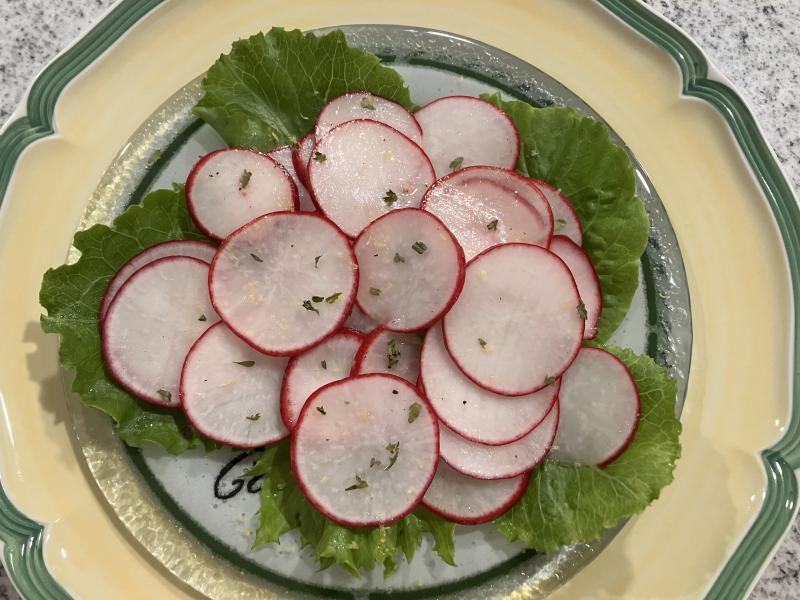Radishes add crunch and spice to summer menus
Last week, I found bunch after bunch of bright-red radishes offered by growers at the Historic Lewes Farmers Market. The bulbs varied slightly in color and shape, with some lighter pink, others deep crimson, some slightly elongated, others perfectly round. They all were topped with crisp green leaves, a distinctive addition to the radishes sold in cellophane bags at the supermarket.
Conventional kitchen advice instructs the cook to cut off the tops and discard them. While removing the tops will keep the greens from leaching moisture out of the radish, don’t just toss them into the compost bin. Instead, trim them off and store them separately to use as part of a green salad mix, or add them to your next stir-fry.
If you’re of a certain age, you may have first encountered radishes in your grammar school classroom. I recall an experiment that featured damp paper towels on which we successfully sprouted tiny radish seeds. They were ideal for impatient students, as the seeds send out green shoots quite quickly. We transplanted the seedlings to small pots and waited for the chance to taste the spicy bulbs that formed.
Not everyone liked the flavor or slight tang of the radish, but we were quite proud of our successful efforts to grow something we could eat. We also saw the obvious difference between the desiccated grocery-store radishes and the juicy versions from our tiny farms.
By way of definition, the radish is an edible root, originally domesticated in Europe. In Latin, its name is radix, meaning root, while its genus in Greek, “Raphanus” or “quickly appearing,” refers to its speedy germination. The ones we’re seeing at the market now were likely planted just four to six weeks ago.
Radishes come in an array of colors — purple, red, white and black — with a juicy texture and flavor ranging from sweet to sharp. They can be round or long and cylindrical with bright-white flesh. The best radishes will be plump and firm, with a slender tail and leaves still attached. However, if those leaves are wilted, expect the radishes to be mealy compared to those with fresh, sprightly leaves.
The most common way to enjoy radishes is to slice them into a salad, adding color, texture and bright flavor. For the salad in the photo, I used a mandoline to thinly slice the radishes. Using a knife will not get the slices quite as evenly thin, but be sure to use the finger protector when scraping the radish along the very sharp blades of the mandoline.
A simple dressing includes olive oil, rice wine vinegar, lemon zest, salt and pepper. To make sure the dressing completely coated the radish slices, I tossed them with the vinaigrette before plating them on lettuce leaves. You could garnish with chopped parsley, tarragon or chives.
Another way to prepare radishes is the same approach for most root vegetables — roasting. This is a good way to use any fresh radishes that may have lost their crispness. They become tender and slightly sweet when roasted, which works well with a drizzle of Balsamic vinegar. Pair them with roasted chicken or pork chops as a surprising side dish.
Radish Salad
Wash radishes and trim off stringy roots. Cut off and reserve greens for another use. Thinly slice the radishes into a mixing bowl using a mandoline. Whisk together oil, vinegar and lemon zest. Arrange the lettuce leaves in a circle on a serving plate and scatter the radish slices across them. Season to taste with salt and pepper; garnish with chopped parsley. Serve chilled. Yield: 4 servings.
Roasted Radishes
Preheat oven to 350 F. Wash radishes; trim off and discard stringy roots. Reserve green tops for another use. Place radishes in a mixing bowl and drizzle with olive oil, tossing to combine. Spread radishes on a baking pan and bake until until tender, about 15 minutes. Drizzle with Balsamic vinegar, and season to taste with salt and pepper. Yield: 4 servings.
























































